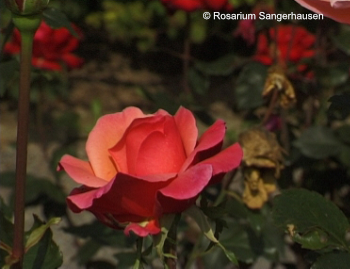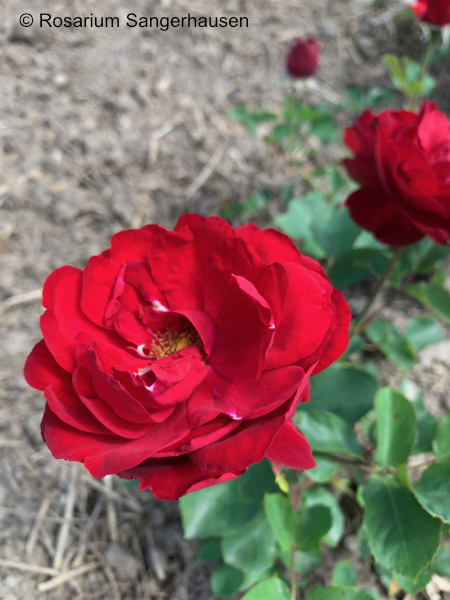The history of the rose of Ravensbrück

"Resurrection", Rose von Ravensbrück, Europa-Rosarium Sangerhausen
The history of the rose of Ravensbrück begins in Lidice. This was a little village, where fascist occupants executed a brutal act of reprisal after Czech resistance fighters attempted to assassinate Reinhard Heydrich.*
199 male inhabitants aged 15 or older were shot, 184 women and girls were deported to Ravensbrück in cattle wagons and 79 children were deported to the ghetto in Lodz and murdered, presumably in Chelmno. 8 children from Lidice who the Nazis considered to be capable of “Germanisation” were given to German families.
After Lidice had been burned it was razed to the ground. Seven days later, the village of Lezaky was also destroyed and its inhabitants murdered or abducted.
After liberation of the Ravensbrück concentration camp 143 women from Lidice returned to their country.
With the campaign “Lidice Shall Live”, collection had begun for donations towards the reconstruction of Lidice, destroyed by German forces, in 1942 already. On June 19 1955, ten years after the end of the Second World War and after reconstruction of the village, a rose garden was inaugurated in Lidice. Most of the rose donations came from England. 32,000 pounds sterling were collected in Stoke-on-Trent and sent for the reconstruction of the area and for the new gardens. Today, the Lidice memorial and garden serve as an international meeting place and museum.
In April 1958, former prisoners from Lidice visited Ravensbrück and planted roses with their own hands. The Czech women thus established the tradition of planting roses on the Ravensbrück mass grave. This act gave the impetus for an international initiative in which former prisoners’ associations from all over Europe donated roses to Ravensbrück.
The International Ravensbrück Committee supported this idea in his circular bulletin in March 1958 and refer to that once more with his letter “To the comrades of the national resistance organizations” from 30. June 1958, signed by Renée Mirande Laval and Marga Jung.
The “Amicale des concentrationnaires et prisonnières politiques luxembourgeoises (1940-1945)” sent roses to Ravensbrück as early at the beginning of April 1958. Lily Unden, the president of the association explained that “the roses were dedicated to the memory of the 40 Luxembourg women who lost their lives in Ravensbrück or as a result of their imprisonment there.” In an exceptional act of generosity, roses from all over the world arrived at Ravensbrück. Roses from Hungary arrived in November 1958, in April 1959 came 100 roses from Denmark and from Soviet Union.

But the idea of uniting roses of different origins in Ravensbrück eventually failed, due to the great contrast in the plants’ hardiness and vigour.
In 1973, Marcelle Dudach-Roset, a member of the Amicale de Ravensbrück (France), arranged for a new Ravensbrück rose to be bred and named “Résurrection”. French women who had been in the Resistance wanted to have a symbol which would give greater vivibility to their own political struggle and their experience of deportation. Michel Kriloff received the commission from the Amicale de Ravensbrück. The Ravensbrück rose was first planted on the 30th anniversary of the liberation of the Ravensbrück Concentration Camp: In the garden of the crypt of the Mémorial de la Déportation in Paris, Madame Ann-Aymone Giscard d’Estaing, wife of the then president of France, planted the first rosebush. “The rose is a witness for the Barbarism of Hitlerism. It is the rose of hope, liberty and peace”, was written in the press release of Amicale. “The Amicale wanted to leave symbols which showed our will to survive and our resistance”, said Marie-Jo Chombart de Lauwe, president of the “Fondation pour la Mémoire da la Déportation”.
In 2005, on the occasion of the 60th anniversary of liberation, the rose was in such demand that there were not enough rosebushes to meet it. Since 2010, it has again been bred by the French rose breeder Orard (Lyon).
“The rose shall flower again for the 70th anniversary of the liberation of Ravensbrück camp”, - thus runs the call for donations. Amicale de Ravensbrück had asked with “Mille Rosiers a Ravensbrück” for donations with success. The initiator of the campaign, Marie-France Cabeza-Marnet, dedicated the campaign to her mother Angèle Cabezza. “Resist, return, be reborn, live on, but live like our rose ’Résurrection’. Thanks to the dedicated efforts by the Amicale de Ravensbrück,a thousand Ravensbrück Roses had found a new home by the end of 2014: on the Ravensbrück mass grave and other places where there were once satellite camps, the roses will continue to keep alive the memory of the women from Ravensbrück.
The Ravensbrück rose has been planted at more than 600 locations since its creations in 1974/75. It is now growing at memorials, in cemeteries, parks, rosaria and public spaces – in France, the Czech Republic, Norway and Germany. The rose blooms in the International Rose Garden in Lidice, in front of the French monument to Ravensbrück in Pére Lachaise Cemetery in Paris, in front of the former Gestapo prison “Arkivet” in Kristiansand, Norway and on the mass grave in front of the camp wall at the Ravensbrück memorial.
Quelle: Meggi Pieschel, Insa Eschebach, Amélie zu Eulenburg; „The Roses in Ravensbrück. A contribution to the history of commemoration.” Exhibition catalogue, 2015 Metropol Verlag
Amicale de RAVENSBRÜCK et des Kommandos Dépendants 10 rue Leroux Porte 25 75116 PARIS E-Mail: rosesorard@gmail.com Kontakt